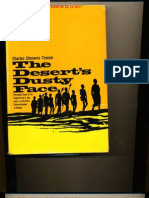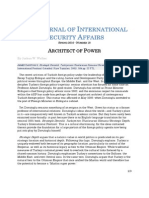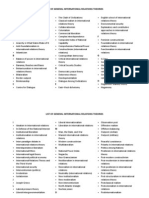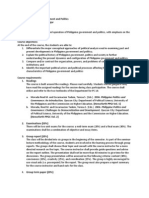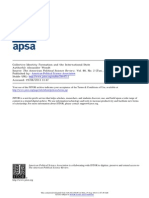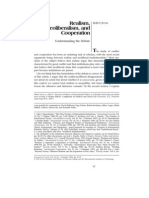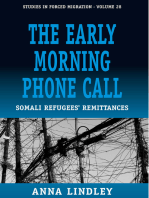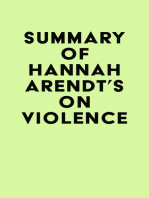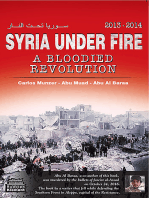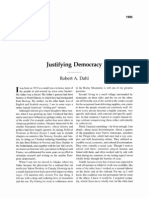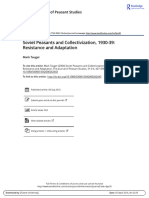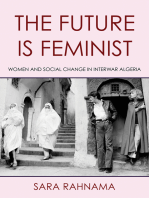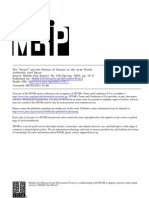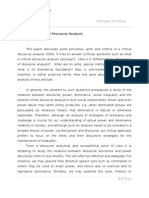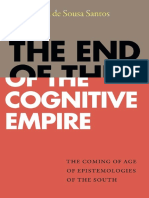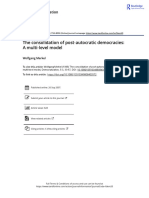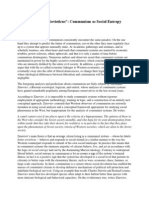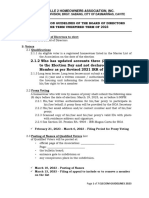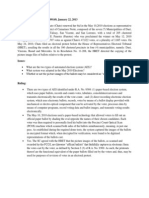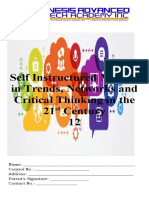Does Oil Hinder Democracy?
Does Oil Hinder Democracy?
Uploaded by
darkzielCopyright:
Available Formats
Does Oil Hinder Democracy?
Does Oil Hinder Democracy?
Uploaded by
darkzielOriginal Description:
Copyright
Available Formats
Share this document
Did you find this document useful?
Is this content inappropriate?
Copyright:
Available Formats
Does Oil Hinder Democracy?
Does Oil Hinder Democracy?
Uploaded by
darkzielCopyright:
Available Formats
Does Oil Hinder Democracy?
Ross, Michael Lewin, 1961World Politics, Volume 53, Number 3, April 2001, pp. 325-361 (Article)
Published by The Johns Hopkins University Press
DOI: 10.1353/wp.2001.0011
For additional information about this article
http://muse.jhu.edu/journals/wp/summary/v053/53.3ross.html
Access Provided by Northwestern University Library at 06/17/10 2:20PM GMT
DOES OIL HINDER DEMOCRACY?
By MICHAEL L. ROSS*
INTRODUCTION
OLITICAL scientists believe that oil has some very odd properties. Many studies show that when incomes rise, governments tend
to become more democratic. Yet some scholars imply there is an exception to this rule: if rising incomes can be traced to a countrys oil
wealth, they suggest, this democratizing effect will shrink or disappear.
Does oil really have antidemocratic properties? What about other minerals and other commodities? What might explain these effects?
The claim that oil and democracy do not mix is often used by area
specialists to explain why the high-income states of the Arab Middle
East have not become democratic. If oil is truly at fault, this insight
could help explainand perhaps, predictthe political problems of oil
exporters around the world, such as Nigeria, Indonesia, Venezuela, and
the oil-rich states of Central Asia. If other minerals have similar properties, this effect might help account for the absence or weakness of democracy in dozens of additional states in sub-Saharan Africa, Latin
America, and Southeast Asia. Yet the oil impedes democracy claim
has received little attention outside the circle of Mideast scholars;
moreover, it has not been carefully tested with regression analysis, either within or beyond the Middle East.
I use pooled time-series cross-national data from 113 states between
1971 and 1997 to explore three aspects of the oil-impedes-democracy
claim. The first is the claims validity: is it true? Although the claim has
been championed by Mideast specialists, it is difficult to test by examining
only cases from the Middle East because the region provides scholars with
* Previous versions of this article were presented to seminars at Princeton University, Yale University, and the University of California, Los Angeles, and at the September 2000 annual meeting of the
American Political Science Association in Washington, D.C. For their thoughtful comments on earlier drafts, I am grateful to Pradeep Chhibber, Indra de Soysa, Geoffrey Garrett, Phil Keefer, Steve
Knack, Miriam Lowi, Ellen Lust-Okar, Lant Pritchett, Nicholas Sambanis, Jennifer Widner, Michael
Woolcock, and three anonymous reviewers. I owe special thanks to Irfan Nooruddin for his research
assistance and advice and to Colin Xu for his help with the Stata. I wrote this article while I was a visiting scholar at The World Bank in Washington, D.C. The views I express in this article, and all remaining errors, are mine alone.
World Politics 53 (April 2001), 32561
326
WORLD POLITICS
INDEX
1.
2.
3.
4.
5.
6.
7.
8.
9.
10.
11.
12.
13.
14.
15.
16.
17.
18.
19.
20.
21.
22.
23.
24.
25.
Brunei (1994)
Kuwait
Bahrain
Nigeria (1991)
Congo, Dem. Rep.
Angola (1996)
Yemen
Oman
Saudi Arabia
Qatar (1994)
Libya (1988)
Iraq (1983)
Algeria
Venezuela
Syria
Norway
Iran (1983)
Ecuador
Malaysia
Indonesia
Cameroon
Lithuania
Kyrgyz Republic (1996)
Netherlands
Colombia
OF
TABLE 1
OIL-RELIANT STATESA
47.58
46.14
45.60
45.38
45.14
45
38.58
38.43
33.85
33.85
29.74
23.48
21.44
18.84
15.00
13.46
11.95
8.53
5.91
5.69
5.63
4.48
4.25
3.14
3.13
a
Oil reliance is measured by the value of fuel-based exports divided by GDP. Most figures
are based on data for 1995 from World Bank (fn. 71).Figures for Brunei, Nigeria, Qatar,
Libya, Iraq, and Iran are the most recent available. Since 1995 figures for Angola and Kyrgyz Republic are not available, 1996 figures are reported.
little variation on the dependent variable: virtually all Mideast governments have been authoritarian since gaining independence. Moreover,
there are other plausible explanations for the absence of democracy in the
Mideast, including the influence of Islam and the regions distinct culture
and colonial history. Does oil have a consistently negative influence on democracy once one accounts for these and other variables?
Second, I examine the claims generality along two dimensions. One
is geographic. For obvious reasons the oil-impedes-democracy claim
has been explored most carefully by Mideast specialists: ten of the fifteen states most reliant on oil wealth are in the Middle East region (see
Table 1). But is oil an obstacle to democracy only in the Mideast, or does
it harm oil exporters everywhere? If the hypothesis is true for all oil-rich
DOES OIL HINDER DEMOCRACY ?
INDEX
1.
2.
3.
4.
5.
6.
7.
8.
9.
10.
11.
12.
13.
14.
15.
16.
17.
18.
19.
20.
21.
22.
23.
24.
25.
Botswana
Zambia
Bahrain
Chile
Angola (1996)
Papua New Guinea
Togo (1991)
Bolivia
Congo, Dem. Rep. (1983)
Jordan
Peru
Central African Republic
Iceland
Zimbabwe
Norway
Belgium
Canada
Australia
Lithuania
Jamaica
Slovak Republic
South Africa
Morocco
Cameroon
Kyrgyz Republic
OF
327
TABLE 2
MINERAL-RELIANT STATESa
35.11
24.97
16.39
12.63
11.5
10.13
7.79
5.53
7.00
5.28
3.84
3.16
3.11
3.00
2.49
2.23
2.22
2.20
1.96
1.87
1.74
1.69
1.65
1.62
1.56
Mineral reliance is measured by the value of nonfuel mineral exports divided by GDP.
Most figures are for 1995 based on data from World Bank (fn. 71). The figures for Congo
and Togo are the most recent available; the 1996 figure is reported for Angola, since no figure for 1995 is available.
states, then its importance has been underappreciated by other political
scientists. If it holds only for states in the Mideast, why is this so?
The other dimension is sectoral: do other types of minerals and
other types of commodities have similar effects on governments? While
oil exporters tend to be concentrated in the Middle East, exporters of
nonfuel minerals are more geographically dispersed (see Table 2). Have
these states, too, been rendered less democratic because of resource
wealth? Or does petroleum have antidemocratic properties that are not
found in other commodities?
Finally, I explore the question of causality: if oil does have antidemocratic effects, what is the causal mechanism? I test three possible
explanations: a rentier effect, which suggests that resource-rich
328
WORLD POLITICS
governments use low tax rates and patronage to relieve pressures for
greater accountability; a repression effect, which argues that resource
wealth retards democratization by enabling governments to boost their
funding for internal security; and a modernization effect, which holds
that growth based on the export of oil and minerals fails to bring about
the social and cultural changes that tend to produce democratic government.
I also have two broader aims. The first is to encourage scholars who
study democracy to incorporate the Middle East into their analyses.
Many global studies of democratization have avoided the Mideast entirely.1 Influential studies by Przeworski and Limongi and Przeworski,
Alvarez, Cheibub, and Limongi simply drop the oil-rich Mideast states
from their database.2 There is, however, no sound analytical reason for
scholars of democracy to exclude these states from their research, and
doing so can only weaken any general findings. It also tends to marginalize the field of Middle East studies.
My second aim is to address the literature on the resource curse.
Many of the poorest and most troubled states in the developing world
have, paradoxically, high levels of natural resource wealth. There is a
growing body of evidence that resource wealth itself may harm a countrys prospects for development. States with greater natural resource
wealth tend to grow more slowly than their resource-poor counterparts.3 They are also more likely to suffer from civil wars.4 This article
suggests as well that there is a third component to the resource curse:
oil and mineral wealth tends to make states less democratic.
1
See, for example, Guillermo ODonnell, Philippe C. Schmitter, and Lawrence Whitehead, eds.,
Transitions from Authoritarian Rule: Prospects for Democracy (Baltimore: Johns Hopkins University
Press, 1986); D. Larry Diamond, Juan J. Linz, and Seymour Martin Lipset, eds., Democracy in Developing Countries (Boulder, Colo.: Lynne Rienner, 1988); Ronald Inglehart, Modernization and Postmodernization (Princeton: Princeton University Press, 1997).
2
Adam Przeworski and Fernando Limongi, Modernization: Theories and Facts, World Politics 49
( January 1997); Adam Przeworski, Michael Alvarez, Jos Antonio Cheibub, and Fernando Limongi,
What Makes Democracies Endure? Journal of Democracy 7 ( January 1996); idem,Democracy and Development: Political Institutions and Well-Being in the World, 19501990 (New York: Cambridge University Press, 2000).
3
Jeffrey D. Sachs and Andrew M. Warner, Natural Resource Abundance and Economic Growth,
Development Discussion Paper no. 517a (Cambridge: Harvard Institute for International Development, 1995); idem, The Big Push, Natural Resource Booms and Growth, Journal of Development
Economics 59 (February 1999); Carlos Leite and Jens Weidmann, Does Mother Nature Corrupt? Natural Resources, Corruption, and Economic Growth, IMF Working Paper, WP/99/85 (1999); Michael
L. Ross, The Political Economy of the Resource Curse, World Politics 51 ( January 1999); R. M. Auty,
Resource Abundance and Economic Development (Oxford: Oxford University Press, 2001).
4
Paul Collier and Anke Hoeffler, On Economic Causes of Civil War, Oxford Economic Papers 50
(October 1998); Indra de Soysa, The Resource Curse: Are Civil Wars Driven by Rapacity or
Paucity? in Mats Berdal and David M. Malone, eds., Greed and Grievance: Economic Agendas in Civil
Wars (Boulder, Colo.: Lynne Rienner, 2000).
DOES OIL HINDER DEMOCRACY ?
329
I begin by outlining the oil-impedes-democracy claim and the limitations of previous work on the topic. I then draw on earlier case studies of oil-rich states to specify three causal mechanisms that might
explain how oil makes governments more authoritarian. The next section presents a model of regime types and describes the research design.
I then present the results of the validity and generality tests and follow
that with a discussion of the results of tests on the causal mechanisms
and a conclusion.
THE CONCEPT OF THE RENTIER STATE
Area specialists often describe most of the governments of the Mideast
and North Africa as rentier states, since they derive a large fraction of
their revenues from external rents.5 More than half of the governments
revenues in Saudi Arabia, Bahrain, the United Arab Emirates, Oman,
Kuwait, Qatar, and Libya have, at times, come from the sale of oil. The
governments of Jordan, Syria, and Egypt variously earn large locational
rents from payments for pipeline crossings, transit fees, and passage
through the Suez Canal. Workers remittances have been an important
source of foreign exchange in Egypt, Yemen, Syria, Lebanon, Tunisia,
Algeria, and Morocco, although these rents go (at least initially) to private actors, not the state. The foreign aid that flows to Israel, Egypt, and
Jordan may also be considered a type of economic rent.
Economists in the early twentieth century used the term rentier
state to refer to the European states that extended loans to nonEuropean governments.6 Mahdavy is widely credited with giving the
term its current meaning: a state that receives substantial rents from
foreign individuals, concerns or governments.7 Beblawi later refined
this definition, suggesting that a rentier state is one where the rents are
paid by foreign actors, where they accrue directly to the state, and where
only a few are engaged in the generation of this rent (wealth), the majority being only involved in the distribution or utilization of it.8
5
Throughout this article I use the term Middle East to include North Africa. I adopt the World
Banks definition of this region: Algeria, Bahrain, Egypt, Iran, Iraq, Israel, Jordan, Kuwait, Lebanon,
Libya, Malta, Morocco, Oman, Qatar, Saudi Arabia, Syria, Tunisia, United Arab Emirates, and Yemen.
6
According to Lenin, The rentier state is a state of parasitic, decaying capitalism, and this circumstance cannot fail to influence all the socio-political conditions of the countries concerned. V. I.
Lenin, Imperialism, the Highest Stage of Capitalism, in Robert C. Tucker, ed., The Lenin Anthology
(New York: W. W. Norton, 1975).
7
Hussein Mahdavy, The Patterns and Problems of Economic Development in Rentier States: The
Case of Iran, in M. A. Cook, ed., Studies in Economic History of the Middle East (London: Oxford University Press, 1970), 428.
8
Hazem Beblawi, The Rentier State in the Arab World, in Hazem Beblawi and Giacomo Luciani, eds., The Rentier State (New York: Croom Helm, 1987), 51. Note that this definition excludes
330
WORLD POLITICS
Claims about the rentier state can be sorted into two categories:
those that suggest oil wealth makes states less democratic and those
that suggest oil wealth causes governments to do a poorer job of promoting economic development. Often the two are conflated. This article focuses on the first claim.
According to Anderson, The notion of the rentier state is one of the
major contributions of Middle East regional studies to political science.9 Indeed, some scholars of democracy now use a version of this
argument to account for the otherwise puzzling states of the Middle
East. Huntington, for example, suggests that the democratic trend may
bypass the Middle East since many of these states depend heavily on
oil exports, which enhances the control of the state bureaucracy.10
Others have adapted the rentier state idea to oil-rich countries outside the Middle East.11
The claim that oil wealth per se inhibits democratization has not
been subjected to careful statistical tests, however, as most quantitative
studies of democracy simply overlook it as an explanatory variable. And
the handful that even acknowledge that oil-rich states have odd properties do little to explain why. Przeworski and his collaborators, for example, drop countries from their database if their ratio of fuel exports
to total exports in 19841986 exceeded fifty percentan eccentric criterion that excludes six oil-rich states, all of which are located on the
Arabian Peninsula.12 Barros study of democracy includes a dummy
variable for states whose net oil exports represent a minimum of twothirds of total exports and are at least equivalent to approximately one
percent of world exports of oil.13 The Barro oil dummy is statistically
significant and negatively correlated with democracy. But as in the
analyses of Przeworski et al., the dummy variable uses an arbitrary cutworkers remittances. As Chaudhry notes, large flows of remittances have different political implications than do large oil rents. See Kiren Aziz Chaudhry, The Price of Wealth: Economies and Institutions
in the Middle East (Ithaca, N.Y.: Cornell University Press, 1997).
9
Lisa Anderson, The State in the Middle East and North Africa, Comparative Politics 20 (October 1987), 9.
10
Samuel P. Huntington, The Third Wave: Democratization in the Late Twentieth Century (Norman:
University of Oklahoma Press, 1991), 3132.
11
See, for example, Olle Trnquist, Rent Capitalism, State, and Democracy: A Theoretical Proposition, in Arief Budiman, ed., State and Civil Society in Indonesia, Monash Papers on Southeast Asia,
no. 22 (1990); Douglas A. Yates, The Rentier State in Africa: Oil Rent Dependency and Neocolonialism in
the Republic of Gabon (Trenton, N.J.: Africa World Press, 1996); Terry Lynn Karl, The Paradox of
Plenty: Oil Booms and Petro-States (Berkeley: University of California Press, 1997); John Clark, PetroPolitics in Congo, Journal of Democracy 8 ( July 1997); idem, The Nature and Evolution of the State
in Zaire, Studies in Comparative International Development 32 (Winter 1998).
12
See Przeworski et al. (fn. 2, 2000), 77.
13
Robert J. Barro, Determinants of Democracy, Journal of Political Economy 107 (December 1999).
DOES OIL HINDER DEMOCRACY ?
331
point to distinguish between oil states and nonoil states and implies that oil has little or no influence on regime type until some threshold is reached.
Qualitative studies of the oil-impedes-democracy hypothesis also
have important limitations. The vast majority have been country-level
case studies of oil-rich states in the Mideast. Although many have been
empirically rich and analytically nuanced, the Mideast is nevertheless a
difficult place to test this claim, since virtually all oil-rich Mideast governments have been highly authoritarian since gaining independence.
The absence of variation on the dependent variableas well as on
Islam, an important control variablehas made testing difficult. It has
also allowed Mideast specialists to neglect tasks that would help
sharpen and refine the oil-impedes-democracy claimdefining the key
variables better, specifying the causal arguments in falsifiable terms, and
outlining the domain of relevant cases to which their arguments apply.
As a result, the notion of the rentier state has suffered from a bad case
of conceptual overstretch: assertions about the influence of oil on Middle East politics have become so general that their validity has been diluted. As Okruhlik observes, The idea of the rentier state has come to
imply so much that it has lost its content.14
One way to restore the usefulness of an overstretched concept is by
testing it statistically. I thus evaluate one core facet of the rentier state
conceptthe oil-impedes-democracy claimwith three questions.
First, is there a statistically valid correlation between oil and authoritarianism once other germane variables are accounted for? Second, can the
claim be generalized both beyond the Middle East and beyond the case
of oil? Finally, if oil thwarts democracy, what is the causal mechanism?
Proponents of the oil-impedes-democracy hypothesis naturally suggest both that it is valid and that it can be generalized to oil exporters
outside the Middle East. Some also imply that other types of commodities have similar effects. Nothing in Beblawis definition, which is
widely accepted among Mideast specialists, restricts the set of rentier
states to oil exporters. In fact, the definition appears to cover many
mineral exporters on the grounds that (1) minerals tend to generate
rents, (2) the rents are largely captured by states via export taxes, corporate taxes, and state-owned enterprises, and (3) mineral extraction
employs relatively little labor. The same definition, however, implies
that exporters of agricultural commodities will not be rentier states.
14
Gwenn Okruhlik, Rentier Wealth, Unruly Law, and the Rise of Opposition, Comparative Politics 31 (April 1999), 308.
332
WORLD POLITICS
This is because (1) agricultural commodities generally do not produce
rents, (2) export revenues in most cases go directly to private actors, not
the state, and (3) agricultural production is more labor intensive and
hence employs a larger fraction of the population for a given value of
exports.15
CAUSAL MECHANISMS
At least three causal mechanisms might explain the alleged link between oil exports and authoritarian rule. The first comes largely from
Mideast specialists and might be called the rentier effect. A close
reading of case studies suggests a second mechanism: a repression effect. Modernization theory implies a third possible cause, which I call
the modernization effect.
THE RENTIER EFFECT
The first causal mechanism comes from the work of Middle East
scholars, who have pondered this issue for over two decades.16 In general they argue that governments use their oil revenues to relieve social
pressures that might otherwise lead to demands for greater accountability. Case studies describe three ways this may occur.17
The first is through what might be called a taxation effect. It suggests that when governments derive sufficient revenues from the sale of
oil, they are likely to tax their populations less heavily or not at all, and
the public in turn will be less likely to demand accountability from
and representation intheir government.18
The logic of the argument is grounded in studies of the evolution of
democratic institutions in early modern England and France. Historians and political scientists have argued that the demand for representation in government arose in response to the sovereigns attempts to raise
15
Note that, by contrast, dependency theory suggests that developing states are politically constrained by their reliance on the export of all types of primary commodities to advanced industrialized
states. See, for example, Fernando Henrique Cardoso and Enzo Faletto, Dependency and Development
in Latin America (Berkeley: University of California Press, 1979); Peter Evans, Dependent Development:
The Alliance of Multinational, State, and Local Capital in Brazil (Princeton: Princeton University Press,
1979); Kenneth A. Bollen, World System Position, Dependency, and Democracy: The Cross-National Evidence, American Sociological Review 48 (August 1983).
16
Perhaps they have thought about it too carefully. Chaudhry (fn. 8), notes that theories of the rentier state far outstrip detailed empirical analysis of actual cases (p. 187).
17
Case studies often conflate these three effects. I treat them here as separate mechanisms to clarify their logic.
18
Giacomo Luciani, Allocation vs. Production States: A Theoretical Framework, in Beblawi and
Luciani (fn. 8).
DOES OIL HINDER DEMOCRACY ?
333
taxes.19 Some Mideast scholars have looked for similar correlations between variations in tax levels and variations in the demand for political
accountability. Crystal found that the discovery of oil made the governments of Kuwait and Qatar less accountable to the traditional merchant
class.20 Brands study of Jordan argued that a drop in foreign aid and remittances in the 1980s led to greater pressures for political representation.21 Yet not all Middle East specialists have been persuaded:
Waterbury argues that neither historically nor in the twentieth century is
there much evidence [in the Middle East] that taxation has evoked demands that governments account for their use of tax monies. Predatory
taxation has produced revolts, especially in the countryside, but there has
been no translation of tax burden into pressures for democratization.22
A second component of the rentier effect might be called the
spending effect: oil wealth may lead to greater spending on patronage, which in turn dampens latent pressures for democratization.23
Entelis, for example, argues that the Saudi Arabian government used
its oil wealth for spending programs that helped reduce pressures for
democracy.24 Vandewalle makes a similar argument about the Libyan
government.25 And Kessler and Bazdresch and Levy find that the
Mexican oil boom of the 1970s helped prop upand perhaps prolongone-party rule.26 While all authoritarian governments may use
19
Charles Tilly, ed., The Formation of National States in Western Europe (Princeton: Princeton University Press, 1975); Robert Bates and Da-Hsiang Donald Lien, A Note on Taxation, Development,
and Representative Government, Politics and Society 14 ( January 1985); Philip T. Hoffman and
Kathryn Norberg, eds., Fiscal Crises, Liberty, and Representative Government, 14501789 (Stanford,
Calif.: Stanford University Press, 1994).
20
Jill Crystal, Oil and Politics in the Gulf: Rulers and Merchants in Kuwait and Qatar (New York:
Cambridge University Press, 1990).
21
Laurie A. Brand, Economic and Political Liberalization in a Rentier Economy: The Case of the
Hashemite Kingdom of Jordan, in Iliya Harik and Denis J. Sullivan, eds., Privatization and Liberalization in the Middle East (Bloomington: Indiana University Press, 1992).
22
John Waterbury, Democracy without Democrats? The Potential for Political Liberalization in
the Middle East, in Ghassan Salam, ed., Democracy without Democrats? The Renewal of Politics in the
Muslim World (New York: I. B. Tauris, 1994), 29.
23
Lam and Wantchekon develop a formal model that makes a similar point, that resource wealth
can impede democracy by enhancing the distributive influence of an elite. Ricky Lam and Leonard
Wantchekon, Dictatorships as a Political Dutch Disease (Manuscript, Department of Political Science, Yale University, January 1999).
24
John P. Entelis, Oil Wealth and the Prospects for Democratization in the Arabian Peninsula:
The Case of Saudi Arabia, in Naiem A. Sherbiny and Mark A. Tessler, eds., Arab Oil: Impact on the
Arab Countries and Global Implications (New York: Praeger, 1976).
25
Dirk Vandewalle, Libya since Independence: Oil and State-Building (Ithaca, N.Y.: Cornell University Press, 1998).
26
Carlos Bazresch and Santiago Levy, Populism and Economic Policy in Mexico, 197082, in
Rudiger Dornbusch and Sebastian Edwards, eds., The Macroeconomics of Populism in Latin America
(Chicago: University of Chicago Press, 1991); Timothy P. Kessler, Global Capital and National Politics:
Reforming Mexicos Financial System (Westport, Conn.: Praeger, 1999).
334
WORLD POLITICS
their fiscal powers to reduce dissent, these scholars imply that oil wealth
provides Middle East governments with budgets that are exceptionally
large and unconstrained.27 Rulers in the Middle East may follow the
same tactics as their authoritarian counterparts elsewhere, but oil revenues could make their efforts at fiscal pacification more effective.
The third component might be called a group formation effect. It
implies that when oil revenues provide a government with enough
money, the government will use its largesse to prevent the formation of
social groups that are independent from the state and hence that may
be inclined to demand political rights. One version of this argument is
rooted in Moores claim that the formation of an independent bourgeoisie helped bring about democracy in England and France.28 Scholars examining the cases of Algeria, Libya, Tunisia, and Iran have all
observed oil-rich states blocking the formation of independent social
groups; all argue that the state is thereby blocking a necessary precondition of democracy.29
A second version of the group-formation effect draws on Putnams
argument that the formation of social capitalcivic institutions that lie
above the family and below the statetends to promote more democratic governance.30 Scholars studying the cases of Algeria, Iran, Iraq,
and the Arab Gulf states have all suggested that the governments oil
wealth has impeded the formation of social capital and hence blocked a
transition to democracy.31
Whether Mideast states use their oil revenues to deliberately inhibit
group formation is a matter of some disagreement. In the case of Libya,
First suggests there is not a consistent policy against the development of
27
Lisa Anderson, Peace and Democracy in the Middle East: The Constraints of Soft Budgets,
Journal of International Affairs 49 (Summer 1995).
28
Barrington Moore, Social Origins of Dictatorship and Democracy (Boston: Beacon Press, 1966).
29
On Algeria, see Clement Henry Moore, Petroleum and Political Development in the Maghreb,
in Sherbiny and Tessler (fn. 24); on Libya, see Ruth First, Libya: Class and State in an Oil Economy,
in Petter Nore and Terisa Turner, eds., Oil and Class Struggle (London: Zed Press, 1980); also on Libya,
see Vandewalle (fn. 25); on Tunisia, see Eva Bellin The Politics of Profit in Tunisia: Utility of the Rentier Paradigm? World Development 22 (March 1994); and on Iran, see Hootan Shambayati, The Rentier State, Interest Groups, and the Paradox of Autonomy: State and Business in Turkey and Iran,
Comparative Politics 26 (April 1994).
30
Robert Putnam, Making Democracy Work: Civic Traditions in Modern Italy (Princeton: Princeton
University Press, 1993).
31
On Algeria, see John P. Entelis, Civil Society and the Authoritarian Temptation in Algerian
Politics, in Augustus Richard Norton, ed., Civil Society in the Middle East, vol. 2 (Leiden: E. J. Brill,
1995); on Iran, see Farhad Kazemi, Civil Society and Iranian Politics, in Norton; on the Gulf states,
see Jill Crystal, Civil Society in the Arab Gulf States, in Norton; on Iraq, see Zuhair Humadi, Civil
Society under the Bath in Iraq, in Jillian Schwedler, ed., Toward Civil Society in the Middle East?
(Boulder, Colo.: Lynne Rienner, 1995). Other scholars have argued that the weakness of civil society
in the Middle East has hampered a transition to democracy, without suggesting that oil wealth is the
source of this weakness.
DOES OIL HINDER DEMOCRACY ?
335
an indigenous bourgeoisie, but the growth of this class is in practice constrained by the states own economic ventures and its links with international capital.32 Chaudhry, by contrast, argues that in the 1970s the
Mideast governments used their oil revenues to develop programs that
were explicitly designed to depoliticize the population. . . . In all cases,
governments deliberately destroyed independent civil institutions while
generating others designed to facilitate the political aims of the state.33
Collectively, the taxation, spending, and group-formation effects
constitute the rentier effect. Together they imply that a states fiscal
policies influence its regime type: governments that fund themselves
through oil revenues and have larger budgets are more likely to be authoritarian; governments that fund themselves through taxes and are
relatively small are more likely to become democratic.
THE REPRESSION EFFECT
A close reading of case studies from the Mideast, Africa, and Southeast
Asia suggests that oil wealth and authoritarianism may also be linked
by repression. Citizens in resource-rich states may want democracy as
much as citizens elsewhere, but resource wealth may allow their governments to spend more on internal security and so block the populations democratic aspirations. Skocpol notes that much of Irans
pre-1979 oil wealth was spent on the military, producing what she calls
a rentier absolutist state.34 Clark, in his study of the 1990s oil boom in
the Republic of Congo, finds that the surge in revenues allowed the
government to build up the armed forces and train a special presidential
guard to help maintain order.35 And Gause argues that Middle East democratization has been inhibited in part by the prevalence of the
mukhabarat (national security) state.36
There are at least two reasons why resource wealth might lead to
larger military forces. One may be pure self-interest: given the opportunity to better arm itself against popular pressures, an authoritarian
government will readily do so. A second reason may be that resource
wealth causes ethnic or regional conflict; a larger military might reflect
the governments response. Mineral wealth is often geographically con32
First (fn. 29), 137.
Kiren Aziz Chaudhry, Economic Liberalization and the Lineages of the Rentier State, Comparative Politics 27 (October 1994), 9.
34
Theda Skocpol, Rentier State and Shia Islam in the Iranian Revolution, Theory and Society 11
(April 1982).
35
Clark (fn. 11, 1997).
36
F. Gregory Gause II, Regional Influences on Experiments in Political Liberalization in the Arab
World, in Rex Brynen, Bahgat Korany, and Paul Noble, eds., Political Liberalization and Democratization in the Arab World, vol. 1, Theoretical Perspectives (Boulder, Colo.: Lynne Rienner, 1995).
33
336
WORLD POLITICS
centrated. If it happens to be concentrated in a region populated by an
ethnic or religious minority, resource extraction may promote or exacerbate ethnic tensions, as federal, regional, and local actors compete for
mineral rights. These disputes may lead to larger military forces and
less democracy in resource-rich, ethnically fractured states such as Angola, Burma, the Democratic Republic of Congo, Indonesia, Nigeria,
Papua New Guinea, Sierra Leone, and South Africa. This mechanism
would be consistent with the research of Collier and Hoeffler and de
Soysa, who find that natural resource wealth tends to make civil war
more likely.37
THE MODERNIZATION EFFECT
Finally, a third explanation can be derived from modernization theory,
which holds that democracy is caused by a collection of social and cultural changesincluding occupational specialization, urbanization, and
higher levels of educationthat in turn are caused by economic development.38 Different scholars emphasize different clusters of social and
cultural changes. Perhaps the most carefully shaped position comes
from Inglehart, who argues that two types of social change have a direct
impact on the likelihood that a state will become democratic:
1. Rising education levels, which produce a more articulate public that is better equipped to organize and communicate, and
2. Rising occupational specialization, which first shifts the workforce into the
secondary sector and then into the tertiary sector. These changes produce a more
autonomous workforce, accustomed to thinking for themselves on the job and
having specialized skills that enhance their bargaining power against elites.39
Although modernization theory does not address the question of resource wealth per se, an implicit corollary is that if economic development does not produce these cultural and social changes, it will not
result in democratization. As Inglehart notes: Is the linkage between
development and democracy due to wealth per se? Apparently not: if
democracy automatically resulted from simply becoming wealthy, then
Kuwait and Libya would be model democracies.40 In other words, if
resource-led growth does not lead to higher education levels and
37
See Collier and Hoeffler (fn. 4); de Soysa (fn. 4).
Seymour Martin Lipset, Some Social Requisites of Democracy: Economic Development and
Political Legitimacy, American Political Science Review 53 (March 1959); Karl W. Deutsch, Social
Mobilization and Political Development, American Political Science Review 55 (September 1961); Inglehart (fn. 1).
39
Inglehart (fn. 1), 163.
40
Ibid., 161.
38
DOES OIL HINDER DEMOCRACY ?
337
greater occupational specialization, it should also fail to bring about democracy. Unlike the rentier and repression effects, the modernization
effect does not work through the state: it is a social mechanism, not a
political one.
The rentier, repression, and modernization effects are largely complementary. The rentier effect focuses on the governments use of fiscal
measures to keep the public politically demobilized; the repression effect stresses the governments use of force to keep the public demobilized; and the modernization effect looks at social forces that may keep
the public demobilized. All three explanations, or any combination of
them, may be simultaneously valid.41
MODEL SPECIFICATION AND RESEARCH DESIGN
To test the oil-impedes-democracy claim, I present a model to predict
regime types and test it using a feasible generalized least-squares
method with a pooled time-series cross-national data set, which includes data on all sovereign states with populations over one hundred
thousand between 1971 and 1997. The model includes five causal variables that according to previous studies are the most robust determinants of democracy. It also includes variables that measure a states oil
and mineral wealth to see if they add explanatory power.
The basic regression model is:
Regimei,t = a1 + b1(Oili,t-5 ) + b2(Mineralsi,t-5 ) + b3(Log Incomei,t-5 )
+ b4 (Islami ) + b5(OECDi ) + b6(Regimei,t-5 ) + b7(Year1 ) . . . + b33(Year26 )
where i is the country and t is the year.
The dependent variable, Regime, is derived from the Polity98 data
set constructed by Gurr and Jaggers.42 Gurr and Jaggers compile two
010 interval scale variables, DEMOC and AUTOC; the former differentiates between states that are relatively democratic, while the latter
variable differentiates between authoritarian states. Since the two indicators contain separate, nonoverlapping types of information about
each country year, I combine them into a single measure by subtracting
41
A fourth explanation has been offered by U.S. vice president Richard Cheney, a political scientist
by training: The problem is that the good Lord didnt see fit to put oil and gas reserves where there are
democratic governments. Cited in David Ignatius, Oil and Politics Mix Suspiciously Well in
America, Washington Post, July 30, 2000, A31.
42
Each of the variables is defined more precisely in Appendix 1. Ted R. Gurr and Keith Jaggers,
Polity 98: Regime Characteristics, 18001998, http://www.bsos.umd.edu/cidcm/polity/, 1999 (consulted March 1, 2000).
338
WORLD POLITICS
the autocracy measure from the democracy measure.43 I then rescale it
as a 010 variable, with 10 representing most democratic.
Oil and Minerals are the independent variables; they measure the export value of mineral-based fuels (petroleum, natural gas, and coal) and
the export value of nonfuel ores and metals exports, as fractions of GDP.
These variables capture both the importance of fuels and minerals as
sources of export revenue and their relative importance in the domestic
economy.44
The right-hand side of the equation also includes five control variables designed to capture the factors most robustly associated with
regime type, for which indicators are available for most of the countries
and years. The first is Income, measured as the natural log of per capita
GDP corrected for purchasing power parity (PPP), in current international dollars. Per capita income has been widely accepted as a correlate
of democracy since Lipset; its validity has been confirmed in more recent tests by Burkhart and Lewis-Beck, Londregan and Poole, Przeworski and Limongi, and Barro.45
The second control variable is Islam, which denotes the Muslim percentage of the states population in 1970.46 Previous studies have suggested that states with large Muslim populations tend to be less
democratic than non-Muslim states.47 Of all the religious categories
tested by Barro, Islam (measured the same way with the same data set)
had by far the largest and most statistically significant influence on a
states regime type.48 Placing Islam in this model has special importance
43
Here I am following the practice of John B. Londregan and Keith T. Poole, Does High Income
Promote Democracy? World Politics 49 (October 1996).
44
Oil and Minerals are similar to the indicators used by Sachs and Warner (fn. 3, 1995) and by Leite
and Weidmann (fn. 3) in their studies of the influence of resource wealth on economic performance.
While Sachs and Warner combine fuels, nonfuel minerals, and agricultural goods into a single variable, I consider them as separate variables to see if their regression coefficients (and hence their influence on regime types) differ.
45
Lipset (fn. 38); Ross E. Burkhart and Michael S. Lewis-Beck Comparative Democracy: The
Economic Development Thesis, American Political Science Review 88 (December 1994); Londregan
and Poole (fn. 43); Przeworski and Limongi (fn. 2); Barro (fn. 13).
46
In virtually all cases, the figure for 1980 (the only other year for which data were available) was
identical to the 1970 figure.
47
Salam (fn. 22); Seymour Martin Lipset,The Social Requisites of Democracy Revisited, American Sociological Review 59 (February1994); Manus Midlarsky, Democracy and Islam: Implications for
Civilizational Conflict and the Democratic Peace, International Studies Quarterly 42 (December 1998).
48
Barro (fn. 13). Observers offer different arguments to explain the negative correlation between
democracy and Islamic populations (.38). See, for example, Hisham Sharabi, Neopatriarchy: A Theory
of Distorted Change in Arab Society (New York: Oxford University Press, 1988); Bernard Lewis, Islam
and Liberal Democracy, Atlantic Monthly 271 (February 1993); and Michael Hudson, The Political
Culture Approach to Arab Democratization: The Case for Bringing It Back In, Carefully, in Brynen,
Korany, and Noble (fn. 36). Although they are negatively correlated for the period covered by this data
set (197197), it is not obvious that they will continue to be negatively correlated in the future. Two
DOES OIL HINDER DEMOCRACY ?
339
because many states with great mineral wealth also have large Muslim
populations, not only in the Middle East but also in parts of Asia (Indonesia, Malaysia, Brunei) and Africa (Nigeria). The simple correlation
between Oil and Islam is 0.44.
The third control variable is OECD, a dummy that is coded 1 for
states that are members of the Organization for Economic Cooperation and Development (excluding newer members Mexico and South
Korea) and 0 for all others. Previous researchers have found that the advanced industrialized states of the OECD are significantly more likely to
be democratic in the postWorld War II era than the states of the developing world, even after the influence of income and other factors are
accounted for.49 There is no consensus on why this is so. It has variously
been attributed to the Wests unique historical trajectory;50 the cultural
influence of Protestantism;51 the residual effects of Western colonialism
on non-Western states;52 and a world system that constrains the
prospects of states in the non-Western periphery.53 Conceivably any
antidemocratic effects from Oil and Minerals might be spurious and
merely reflect the location of most fuel- and mineral-exporting states
in the non-Western world. The OECD dummy helps account for any of
these Western-specific effects, without taking a position on the mechanisms behind it.
The fourth control variable is Regimet-5, which is the dependent variable lagged by five years. Placing it on the right-hand side of the model
has three purposes. First, the most important influence on a states
regime type may often be its own peculiar history; Regimet-5 helps capture any country-specific historical or cultural features that may be
missed by the other right-hand-side variables. Second, including
Regimet-5 helps turn the equation into a change model, transforming
the dependent variable from regime type to the change in a countrys
regime type over a given five-year period. This helps ensure that the restates with large Islamic populations, Nigeria and Indonesia, have recently moved toward democracy,
and some of the most important prodemocracy forces in other Islamic states (including Algeria, Egypt,
Jordan, and Malaysia) are often classified as Islamic traditionalists or fundamentalists. It is instructive to recall that until the third wave of democratization began in the mid-1970s, democracy and
Catholicism were negatively correlated.
49
See Burkhart and Lewis-Beck (fn. 45); Londregan and Poole (fn. 43); Przeworski and Limongi
(fn. 2).
50
See Moore (fn. 28).
51
See Lipset (fn. 38); Huntington (fn. 10).
52
See Robert A. Dahl, Polyarchy: Participation and Opposition (New Haven: Yale University Press,
1971).
53
See Immanuel Wallerstein, The Modern World-System (New York: Academic Press, 1974); Bollen
(fn. 15); Burkhart and Lewis-Beck (fn. 45).
340
WORLD POLITICS
gression will indeed measure both time-series and cross-sectional
changes in regime types. Third, Regimet-5 helps address the problem of
serial correlation that tends to bedevil pooled time-series cross-sectional data sets.54
Finally, the model includes a set of twenty-six dummy variables, one
for each year covered by the data (197197), less one to mitigate autocorrelation. These are designed to capture two types of time-specific effects. The first is the cold war, which may have blocked many transitions
to democracy. The second are contagion effects that influenced states at
different times in Southern and Eastern Europe, Latin America, and
sub-Saharan Africa, where early transitions to democracy appeared to
boost the likelihood of subsequent transitions in proximate states.
The tests were run with a feasible generalized least-squares process
using Stata 6.0.55 Since I include a lagged dependent variable on the
right-hand side of the equation, I correct for first-order autocorrelation
using a panel-specific process, which allows the degree of autocorrelation to vary from country to country.
I use a five-year lag for all independent and control variables. The lag
gives more confidence that the causal arrow is pointing in the right direction; it also enables me to look for factors that have an enduring impact on regime types. As I illustrate below, using shorter lags does not
change the results of the basic model, but it does increase the absolute
value of the coefficient of the lagged dependent variable relative to the
other explanatory variables. Hence with a one-year lag, a countrys current regime type becomes overwhelmingly a function of its regime type
in the previous year, while the influence of other variables is artificially
suppressed.56
RESULTS
For the basic model described below, Stata is able to utilize 2,183
country-year observations from 113 states, out of a possible 3,752
observations from 158 states. The data for each of the variables are summarized in Appendix 2.
54
James A. Stimson, Regression in Space and Time: A Statistical Essay, American Journal of Political Science 29 (November 1985); Nathaniel Beck and Jonathan N. Katz, What to Do (and Not to Do)
with Time-Series Cross-Section Data, American Political Science Review 89 (September 1995).
55
Beck and Katz (fn. 54) recommend using ordinary least squares with panel-corrected standard
errors when working with panel data if the number of units is less than the number of time points. In
this data set the number of units (113) exceeds the number of time points (27).
56
Christopher H. Achen, Why Lagged Dependent Variables Can Suppress the Explanatory Power
of Other Independent Variables (Paper presented at the annual meeting of the Political Methodology
Section of the American Political Science Association, Los Angeles, July 2022, 2000).
DOES OIL HINDER DEMOCRACY ?
341
TABLE 3
RESOURCE WEALTH AND DEMOCRACYa
(DEPENDENT VARIABLE IS REGIME)
Regime
Oil
Minerals
Income (log)
Islam
OECD
Food
Agriculture
Observations
States
Log likelihood
.253***
(.0203)
.0346***
(.0051)
.0459***
(.00778)
.922***
(.105)
.018***
(.00208)
1.47***
(.308)
.894***
(.00846)
.0078***
(.0024)
.00718*
(.00317)
.119***
(.0342)
.0031***
(.000665)
.176*
(.0781)
.25***
(.0203)
.0339***
(.00506)
.0438***
(.0081)
.935***
(.106)
.0178***
(.0021)
1.42***
(.305)
.0244*
(.0102)
.246***
(.0204)
.0393***
(.00543)
.0455***
(.00804)
.965***
(.107)
.0173***
(.00211)
1.44***
(.308)
2182
113
3129
2178
113
3123
2183
113
3133
2498
115
3283
.042
(.0239)
* significant at the 0.05 level; ** significant at the 0.01 level; *** significant at the 0.001 level
a
All independent and control variables are entered with five-year lags, except in column
2, where they are entered with a one-year lag. Standard errors are in parentheses below the
coefficients. Feasible Generalized Least Squares regressions run with Stata 6.0; corrected
for first-order autocorrelation using a panel-specific process. Each regression is run with
dummy variables for every year (but one) covered by the data.
The results of the basic model are reported in Table 3, column 1. All
of the variables are highly significant with the expected signs.57 Both
Oil and Minerals have strong antidemocratic effects; these effects are of
roughly the same magnitude, although the Minerals coefficient is somewhat larger.58
57
Most of the coefficients for the year dummies are also significant: for years 197189 the coefficients
are negative and range from marginally to highly significant; for 1990 the coefficient is negative but not significant; and for years 199196 the coefficients are positive, although all but one (1994) are not significant.
58
These results were unaffected by the inclusion of other variables that are sometimes significant in
democracy regressions, including educational attainment, status as a former British colony, Catholic
population, and trade openness. Only the last variable was significant. When run with a randomeffects process, a Hausman test produces a chi2 of 466 and a P value of 0.000. When run with a fixedeffects process, however, none of the right-hand-side variablesexcept for the lagged dependent
variable and Log Incomeare significant.
342
WORLD POLITICS
Regime
0
0
10
20
30
40
50
Value of Oil Exports (U.S. Dollars, Billion per Year)
FIGURE 1
IMPACT OF OIL EXPORTS ON REGIME
a
This figure shows the net predicted impact of oil exports on the 010 variable Regime, for a
hypothetical country of twenty million people with a per capita income of $1,720 dollars a year, which
is the sample mean. Note the scale on the Y-axis is negative.
The results suggest that the antidemocratic properties of oil and
mineral wealth are substantial: a single standard deviation rise in the
Oil variable produces a .49 drop in the 010 democracy index over the
five-year period, while a standard deviation rise in the Minerals variable
leads to a .27 drop. A state that is highly reliant on oil exportsat the
1995 level of Angola, Nigeria, or Kuwaitwould lose 1.5 points on the
democracy scale due to its oil wealth alone. A state that was equally dependent on mineral exports would lose 2.1 points.
The model also implies, however, that the impact of any new oil or
mineral wealth may be partly offset by a rise in income. To complicate
matters, the influence of Oil and Minerals on Regime is nonlinear, and the
magnitude of their impact depends on the states prior level of income.59
As Figure 1 shows, the marginal influence of Oil on Regime is larger
when oil exports are a small fraction of the economy, and it drops as the
country grows more reliant on oil. While Barro and Przeworski et al.
imply that oil wealth matters only when exports reach extraordinarily
59
These effects occur because Income is entered in the model as a logarithmic function and because
an oil discovery will influence both the numerator and the denominator in the Oil variable.
DOES OIL HINDER DEMOCRACY ?
343
Regime
0
0
5000
10000
15000
20000
25000
30000
Initial per Capita Income (U.S. Dollars)
FIGURE 2
IMPACT OF $10 BILLION ANNUAL RISE IN OIL EXPORTS ON REGIME, BY INITIAL
PER CAPITA INCOME
a
This figure shows the net predicted impact of a $10 billion rise in oil exports on the 010 variable
Regime, by initial per capita income, for a hypothetical country with a population of twenty million,
with no prior oil exports. Note the scale on the Y-axis is negative.
high levels, this test suggests the opposite: barrel for barrel, oil harms
democracy more in oil-poor countries than in oil-rich ones.
The test also implies that oil and mineral wealth cause greater damage to democracy in poor countries than in rich ones (see Figure 2).
Imagine a country whose per capita income is $800 a yearabout the
level of Chad, Mozambique, and Yemenwith a population of twenty
million and no oil exports. Suppose prospectors find an oil field that
produces $10 billion of petroleum each year, all of which is exported.
The new oil would simultaneously boost per capita income (a prodemocratic effect) and raise the Oil variable (an antidemocratic effect).
The model predicts that after five years the government would become
less democratic, losing about .93 on the 010 democracy scale. A comparable discovery in a state whose initial per capita income was
$1,720the sample meanwould lose .54 points; if the per capita income were $8,000about the level of Mexico and Malaysiathe same
oil field would be associated with a drop of just .16 in Regime. This pattern is consistent with the observation that large oil discoveries appear
344
WORLD POLITICS
to have no discernible antidemocratic effects in advanced industrialized
states, such as Norway, Britain, and the U.S., but may harm or destabilize democracy in poorer countries.
To determine how general and robust these effects are, I carry out
five additional tests. First, to see whether the results are sensitive to the
duration of the lag on the right-hand-side variables, I run the same
model using one-year lags on all the explanatory variables (Table 3, column 2). All of the variables remain significant, although the absolute
value of the coefficient on the lagged regime type variable grows, and
the absolute values and significance of the coefficients on the other
variables are reduced, perhaps artificially.60
Next, to see whether other types of commodity exports also inhibit
democratization, I add two variables to the model: Food, which measures the value of all food exports as a fraction of GDP, and Agriculture,
which measures the value of all nonfood agricultural exports as a fraction of GDP. As columns 3 and 4 of Table 3 show, the coefficients on
Food and Agriculture are both positiveunlike Oil and Minerals, which
are negative. These findings are consistent with the rentier state thesis:
oil and other minerals impede democracy, but other primary commoditieswhich generate few or no rents, produce less export income for
the state, and employ a larger fraction of the labor forcedo not.
The third test is designed to see whether the model is heavily influenced by the inclusion of small states in the sample. Some of the states
most dependent on oil have small populations, including Brunei and
the Persian Gulf states of Bahrain, Kuwait, Qatar, and the United Arab
Emirates; it would not be surprising if they had a large influence on the
magnitude and significance of the Oil variable. To determine this, I
placed a dummy variable, Large States, in the model; it was coded 0 if a
states population was below one million and 1 otherwise. The results
are displayed in Table 4, column 1. The coefficient on the population
dummy is positive and significant at the 0.05 level, indicating that
small states do tend to be less democratic than large ones; yet its inclusion has only a tiny influence on the Oil and Minerals coefficients and
leaves them highly significant.
The fourth test looks at whether the apparent effects of Oil and
Minerals are caused by cultural or historical impediments to democratization that are specific to the Middle East and sub-Saharan Africa,
two regions where these states are most heavily concentrated. I add two
dummy variables to the regression, Mideast and SSAfrica, which were
60
See Achen (fn. 56).
DOES OIL HINDER DEMOCRACY ?
345
TABLE 4
RESOURCE WEALTH AND DEMOCRACYa
(DEPENDENT VARIABLE IS REGIME)
1
.209***
(.0205)
.0209***
(.00512)
.0265***
(.00718)
.789***
(.117)
.00538
(.0033)
1.6***
(.31)
.227***
(.0203)
.0138*
(.00557)
.0336***
(.00761)
.895***
(.112)
.013***
(.00238)
1.39***
(.286)
Mideast
.255***
(.0203)
.0333***
(.00511)
.0439**
(.00802)
.947***
(.105)
.0178***
(.00209)
1.41***
(.306)
.828*
(.406)
SSAfrica
Arabian Peninsula
3.65***
(.386)
1.62***
(.2)
2183
113
3133
2183
113
3086
Regime
Oil
Minerals
Income (log)
Islam
OECD
Large States
Observations
States
Log likelihood
.998***
(.194)
3.74***
(.49)
2183
113
3100
* significant at the 0.05 level; ** significant at the 0.01 level; *** significant at the 0.001 level
a
All independent and control variables are entered with five-year lags. Standard errors
are in parentheses below the coefficients. Feasible Generalized Least Squares regressions
run with Stata 6.0; corrected for first-order autocorrelation using panel-specific process.
Each regression is run with dummy variables for every year (but one) covered by the data.
coded 1 if the states were classified by the World Bank as residing in
these regions and 0 otherwise. While the lagged dependent variable
helps control for unspecified country-level effectswhich might
crudely be summarized as the countrys historyMideast and
SSAfrica test for additional region-level effects, or the regions history.
The results are listed in column 2 of Table 4. The coefficients for
both Mideast and SSAfrica are large, negative, and highly significant.
The coefficients on the Oil and Minerals variables are again reduced but
remain highly significant. The Islam variable loses significance, due to
its high correlation with the Mideast variable (=.65).
346
WORLD POLITICS
For the final test, I use a new dummy, Arabian Peninsula, in place of
the Mideast dummy; it was coded 1 for the seven states of the Arabian
Peninsula (Bahrain, Kuwait, Oman, Saudi Arabia, Qatar, the United
Arab Emirates, and Yemen) and 0 otherwise. Conceivably the Mideast
dummy is too broad, since it attempts to capture the effects of residing
in a region that is socially and geologically diverse. The antidemocratic
effects of oil might be somewhat more restricted to the Arabian Peninsula, which is dominated by monarchies, sparsely populated, and endowed with spectacular oil wealth. Using Arabian Peninsula instead of
Mideast reduces the problem of collinearity with Islam, although Arabian Peninsula and Oil remain highly collinear (simple correlation
=.74). Still, while including the Arabian Peninsula dummy reduces the
magnitude of the Oil coefficient by about 60 percent, Oil remains significant at the 0.05 level.
These tests support both the validity and the generality of the oilimpedes-democracy claim. They suggest the following: that a states reliance on either oil or mineral exports tends to make it less democratic;
that this effect is not caused by other types of primary exports; that it is
not limited to the Arabian Peninsula, to the Middle East, or to sub-Saharan Africa; and that it is not limited to small states. These findings
are generally consistent with the theory of the rentier state.
Area specialists might also feel vindicated in noting that in these
tests the most powerful impediments to democracy include the variables Regimet-5, Mideast, and Arabian Peninsula, which represent the accumulation of historical and cultural factors in each country, and in the
Arabian Peninsula and Mideast regions, that are not captured by income, resource wealth, Islam, or non-Western status. This underscores
the critical importance of case studies in explaining regime types.
CAUSAL MECHANISMS
To test the three causal mechanisms I add to the basic model a series of
intervening variables, lagged by one year. Adding new variables reduces
the sample size from 2,183 observations to between 2,183 and 426 observations. As the sample shrinks, it becomes increasingly skewed toward states that are relatively wealthy, democratic, and Western,
introducing a pronounced sample bias. To minimize this problem, after
running each of the following regressions, I run a second regression
using the same reduced sample, but without the intervening variable. I
then compare the two regressions. If the intervening variable is valid, it
should be statistically significant, andif the Oil and Minerals variables
DOES OIL HINDER DEMOCRACY ?
347
are significant in the reduced sampleits inclusion should reduce the
absolute values of the Oil and Minerals coefficients. This provides at
least a crude test of some of the causal mechanisms.
RENTIER EFFECT
To test the rentier hypothesis, I use three indicators. For the taxation
effect I use the variable Taxes, which is the percentage of government
revenue collected through taxes on goods, services, income, profits, and
capital gains. The taxation effect implies that states that fund themselves through these assorted personal and corporate taxes (and hence
have higher values on the Taxes variable) should be more democratic;
conversely, states that fund themselves through other means (such as
trade taxes, parastatals, external grants, and right-of-way fees) should
be more authoritarian. The variable is constructed from data collected
by the International Monetary Fund and covers 104 of the 113 states
in the basic model.
To test the spending effect I use Government Consumption, which
measures government consumption as a percentage of GDP; this includes all current spending for purchases of goods and services (including wages and salaries) by all levels of government. If the spending effect
is valid, higher levels of government spending should result in less democracy. The data cover 104 states and are compiled by the World
Bank, which in turn collects information from the OECD, national statistical organizations, central banks, and World Bank missions.
The third variable is Government/GDP, which measures the share of
GDP accounted for by government activity, in 1985 international prices;
the data are from Summers and Heston.61 This final indicator is one
way to look for a group-formation effect. Proponents of this effect
imply that as governments increase in size (relative to the domestic
economy) they are more likely to prevent the formation of civic institutions and social groups that are independent from the government, and
that the absence of these groups will hinder a transition to democracy.62
Without good indicators for civic institutions or social groups, this hypothesis cannot be tested directly with regression analysis. Still, the
Government/GDP variable offers an indirect test: the greater the governments size (as a fraction of GDP), the less likely that independent social groups will form.
61
Robert Summers and Alan Heston, Penn World Tables, Version 5.6, http://cansim.epas.
utoronto.ca;5680/pwt/pwt.htm/, 1999 (consulted March 1, 2000).
62
Of course, a larger budget may not be the only cause of such government actions, but it is the only
cause that can be linked to resource wealth in an obvious way.
348
WORLD POLITICS
TABLE 5
THE RENTIER EFFECTa
(DEPENDENT VARIABLE
Regime
Oil
Mineral
Income (log)
Islam
OECD
Taxes
Government
Consumption
Government/GDP
Observations
States
Log likelihood
IS REGIME )
.259***
(.021)
.0223***
(.00647)
.0157
(.0113)
1.005***
(.104)
.0165***
(.00205)
1.19***
(.272)
.02***
(.00373)
.243***
(.0211)
.0323***
(.00544)
.0463***
(.00677)
.889***
(.112)
.0191***
(.00218)
1.57***
(.314)
.251***
(.0203)
.0351***
(.00511)
.0369***
(.00675)
.857***
(.106)
.0161***
(.00212)
1.53***
(.303)
.0305***
(.00866)
1698
104
2320
2121
110
3036
.0332***
(.00739)
2168
111
3107
* significant at the 0.05 level; ** significant at the 0.01 level; *** significant at the 0.001 level
a
Independent and control variables are entered with five-year lags; intervening variables
(Taxes, Government Consumption, Government/GDP) are entered with one-year lags. Standard errors are in parentheses below the coefficients. Feasible Generalized Least Squares
regressions run with Stata 6.0; corrected for first-order autocorrelation using panel-specific
process. Each regression is run with dummy variables for every year (but one) covered by
the data.
As Table 5 shows, the coefficient on Taxes is highly significant and
positive: as the rentier effect implies, higher personal and corporate
taxes are strongly associated with more democratic government. Moreover, the inclusion of Taxes produces a 17 percent drop in the Oil coefficient, which implies that the taxation effect may account for part of
the antidemocratic influence of Oil.63 While it is possible that causality
also runs the other waythat regime type influences taxationit
should be in the opposite direction: more democratic governments
63
The Minerals variable is not significant in this sample, making it difficult to draw inferences about
the mineral-exporting states.
DOES OIL HINDER DEMOCRACY ?
349
should be less disposed to fund themselves through personal and corporate taxes, given their unpopularity.
The effect of taxes on regime types turns out to be strictly short
term: when Taxes is introduced into the model with a two- or threeyear lag, its coefficient quickly drops in size and loses significance. This
implies that tax increases have only short-term effects on democracy:
people tend to respond to tax hikes right away or not at all.64
The Government Consumption variable is also highly significant in
the hypothesized direction (Table 5, column 2). When Government
Consumption is included in the model, Oil and Minerals drop slightly,
by 7 and 6 percent, respectively. The spending effect appears to last
longer than the taxation effect: the Government Consumption variable
has much the same effect on regime type after three years as it does
after one.
These results are not likely caused by endogeneity. While there is evidence that regime type influences levels of government consumption,
it is in the opposite direction found here: democratic governments tend
to favor higher levels of social spending than their authoritarian counterparts.65
Finally, Government/GDP is also highly significant with the hypothesized sign: the larger the government, the less movement toward democracy over the following five years. Its inclusion has no effect on the
Oil variable but produces a 12 percent drop in the Minerals variable
(Table 5, column 3).
In short, the results are consistent with all three aspects of the rentier
effect.
REPRESSION EFFECT
I use two variables to test the hypothesis that resource wealth causes
governments to arm themselves more heavily against popular pressures.
The first is Military/GNP, which measures the size of the military budget as a fraction of GNP. The data were originally collected by the Arms
Control and Disarmament Agency (ACDA) of the U.S. government and
64
Note that other studies have found that a governments reliance on personal and corporate tax
revenues is strongly and negatively influenced by per capita income: poor states tend to rely on trade
taxes, rich ones on personal and corporate taxes. See William Easterly and Sergio Rebelo, Fiscal Policy and Economic Growth, Journal of Monetary Economics 32 (December 1993); Howell H. Zee, Empirics of Cross-Country Tax Revenue Comparisons, World Development 24 (October 1996). Since per
capita income is included in the model, the actual effect of Taxes on regime types is probably larger
than the coefficient in this regression suggests.
65
David S. Brown and Wendy Hunter, Democracy and Social Spending in Latin America,
198092, American Political Science Review 93 (December 1999).
350
WORLD POLITICS
cover 101 states between 1985 and 1995.66 Since resource-rich states
tend to have government budgets that are atypically large relative to the
size of their economies, this is a better indicator than military spending as a fraction of government spending.
The second variable is Military Personnel, which measures the size of
the military as a fraction of the labor force; it includes some paramilitary forces if those forces resemble regular units in their organization,
equipment, training, or mission. The data are also from ACDA and are
available from 1985 to 1995 for 105 of the states in the database. Unlike the Military/GNP measure, this indicator helps control for variations
in military wages and the presence of conscription across states.
When Oil, Minerals, and Income are regressed on Military/GNP directly (with a five-year lag), the behavior of oil exporters and mineral
exporters diverges. Oil exports are indeed positively and significantly
correlated with military spending, as the repression hypothesis suggests;
but mineral exports are negatively and significantly associated with
military spending. Neither variable is significantly linked with Military
Personnel.
When Military/GNP is placed in the basic model of regime types, its
coefficient is negative and marginally significant at the 0.10 level; its inclusion produces a 6 percent drop in the Oil coefficient (Table 6). The
Military Personnel coefficient is negative and highly significant, although it paradoxically induces a 7 percent rise in Oil. In both samples
the Minerals coefficient is not significant and cannot be interpreted.
Overall, it appears that oil wealth may be linked to higher levels of
military spending, which in turn tends to impede democracy, as the repression effect suggests. But there is no evidence of a similar pattern for
mineral wealth; nor is there evidence to support the claim that oil or
mineral wealth leads to higher levels of military personnel.
Why do oil-rich governments invest as much as they do on their
militaries? Is it to repress popular pressures, or is it a response to higher
levels of instability? To address this question I use data from the Political Risk Services Group, a private firm that uses subjective measures to
gauge investment risks for its clients. It produces a 06 measure of Ethnic Tensions, which measures the degree of tension within a country attributable to racial, nationality, or language divisions. Scores are
available for 102 states between 1982 and 1997. Higher values indicate
less ethnic tension. When added to the modelfirst separately, then
66
Since the data cover only eleven years, the maximum number of possible observations for these regressions drops from 3,752 to 1,642.
DOES OIL HINDER DEMOCRACY ?
351
TABLE 6
THE REPRESSION EFFECTa
(DEPENDENT VARIABLE
Regime
Oil
Minerals
Income (log)
Islam
OECD
Military/GNP
Military Personnel
Ethnic Tensions
Observations
States
Log likelihood
IS REGIME )
.414***
(.032)
.0591***
(.00566)
.0169
(.0272)
.848***
(.132)
.0173***
(.00266)
.071
(.332)
.0366
(.0197)
.334***
(.0314)
.0679***
(.00632)
.00344
(.0179)
.822***
(.145)
.0158***
(.00235)
.00168
(.355)
.34***
(.0262)
.0517***
(.00609)
.000964
(.0201)
.824***
(.117)
.0263***
(.00251)
.0957
(.3)
.09**
(.0304)
841
101
1228
874
105
1293
.0254
(.0485)
1167
102
1642
* significant at the 0.05 level; ** significant at the 0.01 level; *** significant at the 0.001 level
a
All independent and control variables are entered with five-year lags; intervening variables (Military/GNP, Military Personnel, Ethnic Tensions) are entered with one-year lags.
Standard errors are in parentheses below the coefficients. Feasible Generalized Least
Squares regressions run with Stata 6.0; corrected for first-order autocorrelation using panelspecific process. Each regression is run with dummy variables for every year (but one) covered by the data.
together with Military/GNP, and finally controlling for ethnolinguistic
fractionalizationthe Ethnic Tensions variable is not statistically significant (Table 6, column 3). In other words, tensions caused by racial, national, or language divisions do not explain why oil-rich states spend so
heavily on repression.
MODERNIZATION EFFECT
To test the modernization hypothesis I use eleven indicators to determine whether abnormally low levels of occupational specialization, education, health services, media participation, and urbanization can help
352
WORLD POLITICS
explain the dearth of democracy in the resource-rich states. The large
number of indicators allows me to test both Ingleharts version of modernization theory and earlier versions described by Lerner, Deutsch,
and Lipset.
According to Inglehart, occupational specialization and education
are the key links between economic growth and democracy. To measure
occupational specialization I look at the number of men and women in
the economys secondary (industrial) and tertiary (services) sectors as a
fraction of the men and women in the economically active population.
These data are drawn from the International Labor Organization and
cover 76 of the 113 states used in the basic model.
For educational levels, I use figures on the enrollment of men and
women in secondary school as a fraction of the corresponding age
group in the population at large and figures on college enrollment as a
fraction of the population. Both data sets are collected by national governments and assembled by the United Nations Educational, Scientific,
and Cultural Organization (UNESCO). Figures on secondary enrollment
are available for forty-eight countries; figures on college enrollment are
available for ninety-six countries.
Early proponents of modernization theory suggested that improvements in a populations physical health can also lead to democratization.67 More recently Inglehart has argued that as a populations basic
nutritional and health needs are satisfied, they will increasingly turn
to postmaterialist values, including a desire for self-expression and
individual freedom; this value shift, in turn, will facilitate more democratic government.68 Earlier scholars measured the quality of a populations health by using the number of doctors per capita. Here I use
life expectancy at birth, a measure that also accounts for nutrition levels and the distribution of health services across the population. The
underlying data are compiled by several UN agencies and cover ninety
states.
In Lipsets classic analysis, the greater a societys level of media participation, the more likely it is to be democratic.69 Lipset measured
media participation using telephones, radios, and newspaper copies per
capita. To update these indicators slightly, I measure both the number
of telephone mainlines and televisions per capita. Data on telephone
mainlines and televisions are collected by the International Telecom67
Daniel Lerner, The Passing of Traditional Society (New York: Free Press, 1958); Deutsch (fn. 38).
Inglehart (fn. 1).
69
Lipset (fn. 38).
68
DOES OIL HINDER DEMOCRACY ?
353
TABLE 7
THE MODERNIZATION EFFECTa
(DEPENDENT VARIABLE
Regime
Oil
Minerals
Income (log)
Islam
OECD
Men in
Industry
Women in
Industry
Men in
Services
Women in
Services
Observations
States
Log likelihood
IS REGIME )
.529***
(.0316)
.0182
(.0221)
.146*
(.0666)
.251
(.305)
.0121
(.0082)
.752*
(.419)
.0733***
(.0143)
.462***
(.0408)
.116
(.0202)
.112
(.0635)
.565*
(.271)
.0154**
(.00545)
.652
(.432)
.513***
(.0336)
.0187
(.0207)
.0952
(.0657)
.408
(.343)
.0232***
(.00652)
1.13**
(.372)
.604***
(.0324)
.0315
(.0234)
.115
(.0714)
3.8
(.344)
.000534
(.0104)
.391
(.419)
.0814***
(.0166)
.0685***
(.0155)
626
75
878
615
75
772
622
76
835
.0185***
(.00512)
629
76
921
* significant at the 0.05 level; ** significant at the 0.01 level; *** significant at the 0.001 level
a
All independent and control variables are entered with five-year lags; intervening variables (Men in Industry, Women in Industry, Men in Services, Women in Services) are entered
with one-year lags. Standard errors are in parentheses below the coefficients. Feasible Generalized Least Squares regressions run with Stata 6.0; corrected for first-order autocorrelation using panel-specific process. Each regression is run with dummy variables for every
year (but one) covered by the data.
munications Union and are available for 113 and 110 states, respectively, and cover virtually all country years in the data set.
Finally, Lipset also suggested that higher levels of urbanization will
lead to higher levels of democracy. To measure urbanization I use the
fraction of a states population currently living in urban areas. The data,
collected by the United Nations, are available for all 113 states.
The results from these regressions are reported in Tables 7, 8, and 9.
All of the variables measuring occupational specialization are highly
354
WORLD POLITICS
TABLE 8
THE MODERNIZATION EFFECTa
(DEPENDENT VARIABLE
Regime
Oil
Minerals
Income (log)
Islam
OECD
Male Secondary
Enrollment
Female Secondary
Enrollment
College Enrollment
Observations
States
Log likelihood
IS REGIME )
.378***
(.0449)
.0158
(.00966)
.0251
(.0431)
.258
(.296)
.0393***
(.00507)
.159
(.345)
.004
(.00856)
.378***
(.0451)
.0168
(.00952)
.0255
(.0433)
.364
(.29)
.0385***
(.00479)
.187
(.336)
.34***
(.0334)
.033***
(.00991)
.0517
(.0325)
.678***
(.19)
.0348***
(.00407)
.0759
(.436)
.000812
(.00882)
426
48
566
426
48
563
.00289
(.0105)
688
96
1109
* significant at the 0.05 level; ** significant at the 0.01 level; *** significant at the 0.001 level
a
All independent and control variables are entered with five-year lags; intervening variables (Male Secondary Enrollment, Female Secondary Enrollment, College Enrollment) are entered with one-year lags. Standard errors are in parentheses below the coefficients. Feasible
Generalized Least Squares regressions run with Stata 6.0; corrected for first-order autocorrelation using panel-specific process. Each regression is run with dummy variables for
every year (but one) covered by the data.
significant and positively associated with democracy, as predicted by
proponents of modernization theory. The evidence that oil and mineral
wealth influence occupational specialization, however, is somewhat
weak.70 The variables measuring education, life expectancy, urbanization, and televisions per capita are not significant, while the measure of
70
Neither Oil nor Minerals is significantly correlated with democracy in these reduced samples,
which makes it hard to be confident about these results. When Oil and Minerals are regressed on each
of the four variables for occupational specialization (with Income and Islam included as control variables), the results are mixed: Oil is negatively correlated with Men in Industry but positively correlated
with Women in Industry; Minerals is not significantly correlated with Men in Industry and is negatively,
but weakly, linked to Women in Industry.
DOES OIL HINDER DEMOCRACY ?
355
TABLE 9
THE MODERNIZATION EFFECTa
(DEPENDENT VARIABLE
1
Regime
Oil
Minerals
Income (log)
Islam
OECD
Telephones
TVs
Life
Expectancy
Urban
Observations
States
Log likelihood
IS REGIME )
.196***
(.0225)
.04***
(.00551)
.0085
(.0152)
.882***
(.134)
.023***
(.00231)
1.75***
(.351)
.413***
(.0516)
.0247
(.039)
.0376
(.0605)
1.07***
(.315)
.0104
(.0168)
.041
(.412)
.253***
(.0203)
.0346***
(.00509)
.0441***
(.008)
.983***
(.149)
.0174***
(.00213)
1.51***
(.31)
.00096
(.00079)
.00378
(.0616)
.194***
(.0232)
.0463***
(.00609)
.00929
(.016)
1.24***
(.119)
.0194***
(.00214)
2.96***
(.482)
.00543***
(.00118)
1830
113
2830
1831
110
2676
777
103
857
.00278
(.005)
2183
113
3133
* significant at the 0.05 level; ** significant at the 0.01 level; *** significant at the 0.001 level
a
All independent and control variables are entered with five-year lags; intervening variables (Telephones, TVs, Life Expectancy, Urban) are entered with one-year lags. Standard errors are in parentheses below the coefficients. Feasible Generalized Least Squares
regressions run with Stata 6.0; corrected for first-order autocorrelation using panel-specific
process. Each regression is run with dummy variables for every year (but one) covered by
the data.
telephones per capita is highly significant but negatively correlated with
democracy.
There are at least two ways to interpret these results. One is that the
modernization effect is essentially valid but that occupational specialization is the only real causal mechanism behind it, with the other correlates of modernization being epiphenomenal. A second interpretation
is that in resource-rich countries both the modernization effect and the
spending effect occur simultaneously: relatively few people are drawn
into the industry and service sectors; yet thanks to its large revenues,
356
WORLD POLITICS
the government can generously subsidize education, health care, and
other services. The result is that the public enjoys generous social services yet is politically hampered by two antidemocratic forces: a lack of
occupational specialization and a government that uses its fiscal powers
to dampen dissent.
The results of these tests are at least weakly consistent with each of
the three causal mechanisms. Collectively, they provide quantitative
backing for the rentier effects described by a generation of Mideast
specialists, for the repression effects observed in the case studies above,
and for a modified form of the modernization thesis. Still, the causality
tests rely on data that are incomplete and potentially biased, so the results should be treated as suggestive, not conclusive.
CONCLUSION
This article has four main findings. First, the oil-impedes-democracy
claim is both valid and statistically robust; in other words, oil does hurt
democracy. Moreover, oil does greater damage to democracy in poor
states than in rich ones, and a given rise in oil exports will do more harm
in oil-poor states than in oil-rich ones. Hence, oil inhibits democracy
even when exports are relatively small, particularly in poor states.
Second, the harmful influence of oil is not restricted to the Middle
East. Oil wealth has probably made democratization harder in states
like Indonesia, Malaysia, Mexico, and Nigeria; it may well have the
same affect on the oil-rich states of Central Asia.
The third finding is that nonfuel mineral wealth also impedes democratization. While the major oil exporters are concentrated in the
Mideast, major mineral exporters are scattered across Africa, Asia, and
the Americas; this group includes many states where progress toward
democracy has been halting or elusive, including Angola, Chile, the
Democratic Republic of Congo, Cambodia, and Peru.
Each of these findings runs counter to the assumptions of earlier
scholars that the antidemocratic effects of oilif they existedwere
restricted to the Middle East, that they influenced only states that were
almost wholly dependent on oil, and that they did not extend to the
mineral-rich states.
The fourth finding is that there is at least tentative support for three
causal mechanisms that link oil and authoritarianism: a rentier effect,
through which governments use low tax rates and high spending to
dampen pressures for democracy; a repression effect, by which governments build up their internal security forces to ward off democratic
DOES OIL HINDER DEMOCRACY ?
357
pressures; and a modernization effect, in which the failure of the population to move into industrial and service sector jobs renders them less
likely to push for democracy. The links between mineral wealth and authoritarianism are more elusive: the mineral exporters appear to suffer
from a rentier effect but not a repression effect, and there is only weak
evidence that they are afflicted by a modernization effect.
Collectively, these findings should help vindicate two very different
theories of comparative politics: modernization theory, which after
falling out of favor in the 1970s and 1980s made a strong comeback in
the 1990s; and the theory of the rentier state, which has long been
championed by Middle East area specialists but overlooked by scholars
of democratization.
They also highlight the value of bringing cross-national quantitative
studies into closer contact with area studies. Global studies of democracy have generally overlooked the Mideast, a practice that is difficult
to justify methodologically (since it arbitrarily truncates the researchers
sample of states) and one that has contributed to a belief that the Middle East region is sui generis. Of course, the history and culture of the
Mideast are exceptional: note the enormous coefficient on the Mideast
dummy variable in Table 4. But excluding Middle Eastern states from
large-N studies of democracy can only widen the gap between area
studies and the rest of political science. It also deprives mainstream political science of the many insights developed by area studies scholars
insights that, like the oil-impedes-democracy claim, may turn out to
have general applications.
Finally, these findings have implications for the fate of resource-rich
states across the developing world. Many of the worlds most troubled
states have high levels of oil and mineral wealth. Earlier studies have
shown that resource wealth tends to reduce economic growth and to increase the likelihood of civil war. This article suggests there is a third
component to resource curse: authoritarian rule.
These three effects may interact in pernicious ways, creating a resource trap. Authoritarian governments may be less able to resolve domestic conflicts and hence more likely to suffer from civil war. Slow
growth may make domestic unrest tougher to resolve; civil wars, in
turn, wreak economic havoc. There is nothing inevitable about the resource curse: states like Malaysia, Chile, and Botswana have done relatively well despite their oil and mineral wealth. Yet most others have
foundlike King Midasthat their resource wealth can be an unexpected source of grief.
358
WORLD POLITICS
APPENDIX 1: DEFINITION OF VARIABLES 71
Regime is a 010 variable indicating a countrys regime type, with 0 as a
perfect autocracy and 10 a full democracy. It is taken from the Polity 98
data set compiled by Gurr and Jaggers, who assign a 010 indicator for
both level of autocracy and level of democracy.72 Each is a composite of
underlying variables that measure the way chief executives are recruited, whether they gain office through competitive elections,
whether nonelites may obtain executive office, and whether they are
constrained by, and accountable to, other actors. Following Londregan
and Poole, I transform these two measures into a single indicator by
subtracting the autocracy measure from the democracy measure and by
rescaling the resulting 10 to 10 scale as a 0 to 10 scale.73 For the six
states with populations greater than one million for which Gurr and
Jaggers offer no indicators (Austria, Cameroon, Democratic Republic
of Congo, Libya, Sierra Leone, and Switzerland), I use data from Freedom House (197298) instead, summing their measures for political
rights and civil liberties and converting the results to the 010 scale.
Log Income is the natural log of real per capita GDP, in current international dollars. Most of the data come from Summers and Heston;
missing values have been imputed using data from the World Bank.74
Oil is the export value of mineral-based fuels as a percentage of GDP.
Mineral-based fuels include petroleum, natural gas, and coal, as classified under SITC revision 1, section 3. Following the practice of Sachs
and Warner, I corrected the export figures for Singapore and Trinidad
to reflect net exports, since both states are transshipment points for raw
materials extracted in nearby states.75 The values for both states were
set at 0.01.
Minerals is the export value of nonfuel minerals as a percentage of
GDP; it includes all ores and metals classified under SITC revision 1, sections 27, 28, and 68. Following the practice of Sachs and Warner, I corrected the export figures for Singapore and Trinidad to reflect net
exports, since both states are transshipment points for raw materials extracted in nearby states.76 The values for both states were set at 0.01.
71
Unless otherwise indicated, the data below were derived from World Bank, World Development
Indicators, CD-ROM (Washington, D.C.: World Bank, 1999).
72
Gurr and Jaggers (fn. 42)
73
Londregan and Poole (fn. 43).
74
Summers and Heston (fn. 61).
75
Sachs and Warner (fn. 3, 1999).
76
Ibid.
DOES OIL HINDER DEMOCRACY ?
359
Islam is the percentage of the population whose professed religious
affiliation in 1970 was Muslim.77
OECD is a dummy variable coded 1 for the following states and 0 for
all others: Australia, Austria, Belgium, Canada, Denmark, Finland,
France, Germany, Greece, Iceland, Ireland, Italy, Japan, Luxembourg,
Netherlands, New Zealand, Norway, Portugal, Spain, Sweden,
Switzerland, United Kingdom, United States.
Agriculture is the export value of all nonfood agricultural raw materials, as a percentage of GDP. This includes all commodities classified as
falling in SITC revision 1, section 2 (excluding divisions 22, 27, and 28).
Food is the export value of all edible agricultural commodities, as a
percentage of GDP. This includes all commodities classified as falling in
SITC sections 0, 1, and 4, and division 22.
Large States is a dummy variable coded 1 for states with populations
over one million at any point between 1971 and 1997, and 0 otherwise.
Mideast is a dummy variable coded 1 for the following states and 0
otherwise: Algeria, Bahrain, Egypt, Iran, Iraq, Israel, Jordan, Kuwait,
Lebanon, Libya, Morocco, Oman, Qatar, Saudi Arabia, Syria, Tunisia,
United Arab Emirates, and Yemen.
SSAfrica is a dummy variable coded 1 for states classified by the
World Bank as residing in sub-Saharan Africa and 0 otherwise.
Arabian Peninsula is a dummy variable coded 1 for the states on the
Saudi Arabian peninsula (Bahrain, Kuwait, Oman, Saudi Arabia,
Qatar, the United Arab Emirates, and Yemen) and 0 otherwise.
Men in Industry and Women in Industry indicate the fraction of the
total working population of each gender group working in activities defined by the ILO as industry. This includes mining and quarrying (including oil production), manufacturing, electricity, gas and water, and
construction, corresponding to major divisions 25 (ISIC revision 2) or
tabulation categories CF (ISIC revision 3). The data are compiled by
the World Banks Development Data Group using an ILO database corresponding to table 2a in its Yearbook of Labour Statistics.
Men in Services and Women in Services indicate the fraction of the
total working population of each gender group working in activities defined by the ILO as services. Services include wholesale and retail trade
and restaurants and hotels; transport, storage, and communications; financing, insurance, real estate, and business services; and community,
social, and personal services, corresponding to major divisions 69 (ISIC
77
David B Barrett, ed., World Christian Encyclopedia (New York: Oxford University Press, 1982).
360
WORLD POLITICS
revision 2) or tabulation categories GP (ISIC revision 3). The data are
compiled by the World Banks Development Data Group using an ILO
database corresponding to table 2a in its Yearbook of Labour Statistics.
Male Secondary Enrollment and Female Secondary Enrollment indicate
the fraction of males and females enrolled in secondary school, relative
to their numbers in the population. The data are reported to the United
Nations Educational, Scientific, and Cultural Organization (UNESCO)
by national education authorities.
College Enrollment indicates the fraction of the population enrolled in
college. The data are reported to UNESCO by national education authorities.
Life Expectancy indicates the life expectancy at birth of both males and
females. The underlying figures are from the United Nations Department of Economic and Social Affairs, Population and Vital Statistics Report; demographic and health surveys from national sources; and United
Nations Childrens Fund (UNICEF), The State of the Worlds Children, 1999.
Urban is the midyear population of areas defined as urban in each
country and reported to the United Nations, expressed as a fraction of
the total population. The data are from from the United Nations, World
Urbanization Prospects: The 1996 Revision.
Telephones is the number of telephone mainlines (that is, separate
lines to a given household or firm) per thousand people. The data are
derived from the International Telecommunication Union (ITU), World
Telecommunication Development Report.
TVs is the number of televisions per thousand people, according to
an annual questionnaire sent to member countries by the ITU. The data
are derived from the ITU, World Telecommunication Development Report.
Taxes is the percentage of government revenue raised through taxes
on goods, services, income, profits, and capital gains. The data are collected by the IMF.
Government Consumption, expressed as a percentage of GDP, includes
all current expenditures for purchases of goods and services by all levels of government, excluding most government enterprises. It also includes capital expenditure on national defense and security. The data
are collected from the OECD and from national statistical organizations
and central banks by visiting and resident World Bank missions; they
are published by the World Bank.
Government/GDP is the share of GDP accounted for by government
activity, in 1985 international prices. The data are from the Penn World
Tables.
Military/GNP measures the size of the military budget as a fraction of
DOES OIL HINDER DEMOCRACY ?
361
GNP. The data cover 198595; they were originally collected by the Arms
Control and Disarmament Agency (ACDA) of the U.S. government.
Military Personnel measures the size of the military as a percentage
of the labor force; it includes some paramilitary forces if those forces
resemble regular units in their organization, equipment, training, or
mission. The data are also from ACDA and cover 198595.
Ethnic Tensions is a 06 interval-level variable that measures the degree of tension within a country attributable to racial, nationality, or
language divisions. The data cover 97 states between 1982 and 1997;
the codings are carried out by a private firm, the Political Risk Services
Group, and published in their monthly International Country Risk
Guide; they are also available as the IRIS-3 computer database. The
monthly data have been changed into annual data by taking the mean
of the twelve monthly values.
APPENDIX 2:
SUMMARY OF VARIABLES
Variable
Obs.
Mean
Std. Dev.
Min
Regime
Log Income
Oil
Minerals
3752
3316
2322
2865
4528
4336
2511
2504
814
798
810
813
607
607
1272
4372
1527
3129
3040
2325
3538
2277
1298
1440
1739
4.48
7.45
5.5
2.25
.163
25
5.73
1.68
29.4
15.5
39
52
57.7
58
16.9
46.1
62.5
106
151
50.9
15.2
23.8
4.36
1.84
3.791
3.79
1.2
14.1
5.8
.369
36.6
6.23
2.88
12.7
8.99
14.3
25.6
27.9
29.9
16.9
25
11.7
154
169
18.7
6.51
11.9
6.64
2.6
1.633
0
4.53
0
0
0
0
0
0
.4
0
5
9
3
1.3
.1
2.24
31.2
.1
0
0
.897
0
0
0
0
OECD
Islam
Food
Agriculture
Men in Industry
Women in Industry
Men in Services
Women in Services
Male Secondary
Female Secondary
College
Urban
Life Expectancy
Telephones
TVs
Taxes
Govt. Consumption
Government/GDP
Military/GNP
Military Personnel
Ethnic Tensions
Max
10
10.43
115.6
55.1
1
99.7
45.9
31.6
66.9
50.2
69.3
100
98.6
98.5
97.7
100
79.8
691
838
101
76.2
91.2
102
29.6
6
You might also like
- Political Economy of Middle East and North AfricaDocument16 pagesPolitical Economy of Middle East and North AfricaalexandramihaiNo ratings yet
- Dahl PolyarchyDocument6 pagesDahl PolyarchyGeorge Ungureanu100% (1)
- The New Political Islam: Human Rights, Democracy, and JusticeFrom EverandThe New Political Islam: Human Rights, Democracy, and JusticeNo ratings yet
- 1966: The Desert's Dusty Face: Personal Story of An Englishman's Ten Years As A District Commisioner in Kenya. by Charles Chenevix TrenchDocument2 pages1966: The Desert's Dusty Face: Personal Story of An Englishman's Ten Years As A District Commisioner in Kenya. by Charles Chenevix TrenchLucas Daniel SmithNo ratings yet
- Davutoglu Strategic Depth Journal of International Security Affairs - 385Document3 pagesDavutoglu Strategic Depth Journal of International Security Affairs - 385Саша ПаповићNo ratings yet
- Moyn The Political Origins of Global JusticeDocument28 pagesMoyn The Political Origins of Global JusticeRodrigo ChaconNo ratings yet
- List of General International Relations TheoriesDocument3 pagesList of General International Relations Theorieschunwing96124100% (2)
- Making War and Building Peace: United Nations Peace OperationsFrom EverandMaking War and Building Peace: United Nations Peace OperationsNo ratings yet
- Madison Vs DahlDocument5 pagesMadison Vs Dahlapi-283751722No ratings yet
- Pol Sci 14Document6 pagesPol Sci 14sue_quirante100% (1)
- Meaning and Scope of School Administration and SupervisionDocument12 pagesMeaning and Scope of School Administration and SupervisionFlorenz Montalban Taja Fasomingo100% (1)
- Morlino - Hybrid Regimes in TransitionDocument26 pagesMorlino - Hybrid Regimes in TransitionDomnica GoroveiNo ratings yet
- The New Authoritarianism in the Middle East and North AfricaFrom EverandThe New Authoritarianism in the Middle East and North AfricaNo ratings yet
- The Rentier State in The Middle EastDocument34 pagesThe Rentier State in The Middle EastynsozNo ratings yet
- Med 2020Document122 pagesMed 2020ISPINo ratings yet
- Costly Democracy: Peacebuilding and Democratization After WarFrom EverandCostly Democracy: Peacebuilding and Democratization After WarNo ratings yet
- The Gulf War, Iraq and Western Liberalism - Peter GowanDocument42 pagesThe Gulf War, Iraq and Western Liberalism - Peter GowanpeterVoter100% (1)
- Realism and Us Iran Relations PDFDocument5 pagesRealism and Us Iran Relations PDFAchmad Rifaie de JongNo ratings yet
- Conflict Dynamics: Civil Wars, Armed Actors, and Their TacticsFrom EverandConflict Dynamics: Civil Wars, Armed Actors, and Their TacticsNo ratings yet
- Classical Realism and Security StudiesDocument21 pagesClassical Realism and Security StudiesMaDa Midy100% (1)
- The Autumn of Dictatorship: Fiscal Crisis and Political Change in Egypt under MubarakFrom EverandThe Autumn of Dictatorship: Fiscal Crisis and Political Change in Egypt under MubarakNo ratings yet
- Journal of Democracy 2007 1Document15 pagesJournal of Democracy 2007 1James MuldoonNo ratings yet
- Ramsbotham, The Analisys of Intractable Conflict - A Tribute To AzarDocument19 pagesRamsbotham, The Analisys of Intractable Conflict - A Tribute To AzarThamirys CavalcanteNo ratings yet
- Identity Formation and The International StateDocument14 pagesIdentity Formation and The International StateGünther BurowNo ratings yet
- A Gamlen Migration and Global GovernanceDocument34 pagesA Gamlen Migration and Global Governanceandreea_dican100% (1)
- A Young Palestinian's Diary, 1941–1945: The Life of Sami 'AmrFrom EverandA Young Palestinian's Diary, 1941–1945: The Life of Sami 'AmrNo ratings yet
- Jervis Realism Neoliberalism Cooperation DebateDocument22 pagesJervis Realism Neoliberalism Cooperation Debatemcqueen2007No ratings yet
- Misunderstanding The Somali Crisis By: I.M. LewisDocument4 pagesMisunderstanding The Somali Crisis By: I.M. LewisAbuAbdur-RazzaqAl-MisriNo ratings yet
- The Perils of Joy: Contesting Mulid Festivals in Contemporary EgyptFrom EverandThe Perils of Joy: Contesting Mulid Festivals in Contemporary EgyptNo ratings yet
- Wendt 1992 PDFDocument36 pagesWendt 1992 PDFMario HerránNo ratings yet
- The Clash of Ideas in World Politics: Transnational Networks, States, and Regime Change, 1510-2010From EverandThe Clash of Ideas in World Politics: Transnational Networks, States, and Regime Change, 1510-2010No ratings yet
- Jabri-Peacebuilding A Colonial or A Postcolonial Rationality. Vivienne JabriDocument15 pagesJabri-Peacebuilding A Colonial or A Postcolonial Rationality. Vivienne JabriLucía López AriasNo ratings yet
- The Law of The United NationsDocument47 pagesThe Law of The United NationsHabibur RahmanNo ratings yet
- End of The Post Colonial StateDocument28 pagesEnd of The Post Colonial StateOpie UmsgoodNo ratings yet
- Paradoxes of Populism: Troubles of the West and Nationalism's Second ComingFrom EverandParadoxes of Populism: Troubles of the West and Nationalism's Second ComingNo ratings yet
- International Relations Theory On Realism PRESENTATIONDocument20 pagesInternational Relations Theory On Realism PRESENTATIONGRANT NWAOBURUNo ratings yet
- The Blackwell Encyclopedia of Political ThoughtDocument1 pageThe Blackwell Encyclopedia of Political ThoughtCorina Taraș-LunguNo ratings yet
- Justifying Democracy - DahlDocument7 pagesJustifying Democracy - DahlTelma Rocha Lisowski100% (1)
- The Invention of International Relations Theory: Realism, the Rockefeller Foundation, and the 1954 Conference on TheoryFrom EverandThe Invention of International Relations Theory: Realism, the Rockefeller Foundation, and the 1954 Conference on TheoryNo ratings yet
- Soviet Peasants and Collectivization 1930-39 - Resistance and AdaptationDocument31 pagesSoviet Peasants and Collectivization 1930-39 - Resistance and AdaptationpointlessNo ratings yet
- Egypt and the Contradictions of Liberalism: Illiberal Intelligentsia and the Future of Egyptian DemocracyFrom EverandEgypt and the Contradictions of Liberalism: Illiberal Intelligentsia and the Future of Egyptian DemocracyNo ratings yet
- The Future Is Feminist: Women and Social Change in Interwar AlgeriaFrom EverandThe Future Is Feminist: Women and Social Change in Interwar AlgeriaNo ratings yet
- The Straussian Reception of Plato and Na PDFDocument23 pagesThe Straussian Reception of Plato and Na PDFAl-ahmadinejadNo ratings yet
- Anglo-American Relations and the Transmission of Ideas: A Shared Political Tradition?From EverandAnglo-American Relations and the Transmission of Ideas: A Shared Political Tradition?Alan P. Dobson (1951-2022)No ratings yet
- 'Street' and The Politics of Dissent in The Arab World - Asef BayatDocument9 pages'Street' and The Politics of Dissent in The Arab World - Asef BayatnailsatliganNo ratings yet
- Britain's Informal Empire in The Gulf, 1820 - 1971Document9 pagesBritain's Informal Empire in The Gulf, 1820 - 1971Érika MelekNo ratings yet
- Principles of Critical Discourse AnalysisDocument14 pagesPrinciples of Critical Discourse AnalysismaskugaNo ratings yet
- The 'Return' of The National State in The Current Crisis of The World MarketDocument7 pagesThe 'Return' of The National State in The Current Crisis of The World MarketbowssenNo ratings yet
- Boaventura de Sousa Santos The End of The Cognitive Empire - The Coming of Age of Epistemologies of The South Duke University Press 2018 - CompressedDocument391 pagesBoaventura de Sousa Santos The End of The Cognitive Empire - The Coming of Age of Epistemologies of The South Duke University Press 2018 - CompressedEdna lizeth Hernandez OrozcoNo ratings yet
- America and the Intellectual Cold Wars in EuropeFrom EverandAmerica and the Intellectual Cold Wars in EuropeRating: 5 out of 5 stars5/5 (1)
- The Israeli Republic: An Iranian Revolutionary's Journey to the Jewish StateFrom EverandThe Israeli Republic: An Iranian Revolutionary's Journey to the Jewish StateRating: 1.5 out of 5 stars1.5/5 (1)
- Twilight of the Titans: Great Power Decline and RetrenchmentFrom EverandTwilight of the Titans: Great Power Decline and RetrenchmentNo ratings yet
- Transatlantic traumas: Has illiberalism brought the West to the brink of collapse?From EverandTransatlantic traumas: Has illiberalism brought the West to the brink of collapse?No ratings yet
- Kandil, Hazem - The Power Triangle - Military, Security, and Politics in Regime Change-Oxford University Press (2016)Document425 pagesKandil, Hazem - The Power Triangle - Military, Security, and Politics in Regime Change-Oxford University Press (2016)xyz xyz100% (1)
- Globalization Technology Philosophy PDFDocument258 pagesGlobalization Technology Philosophy PDFunschuldNo ratings yet
- Europe's Decline and Fall: The Struggle Against Global IrrelevanceFrom EverandEurope's Decline and Fall: The Struggle Against Global IrrelevanceNo ratings yet
- Peacebuilding in Practice: Local Experience in Two Bosnian TownsFrom EverandPeacebuilding in Practice: Local Experience in Two Bosnian TownsNo ratings yet
- 1520823047 08 คณะรัฐศาสตร์ 61Document14 pages1520823047 08 คณะรัฐศาสตร์ 61毛笔No ratings yet
- The Consolidation of Post Autocratic Democracies A Multi Level ModelDocument36 pagesThe Consolidation of Post Autocratic Democracies A Multi Level Modeldsad dsaNo ratings yet
- Homo Sovieticus Tom SunicDocument5 pagesHomo Sovieticus Tom SunicsnezanaNo ratings yet
- Essay Topic Wise PYQ (1993-2023)Document14 pagesEssay Topic Wise PYQ (1993-2023)extraterrestrial2024No ratings yet
- Ecomments 1-17-12Document142 pagesEcomments 1-17-12Isaac GonzalezNo ratings yet
- Beverley - Latinoamericanism After 9-11Document63 pagesBeverley - Latinoamericanism After 9-11Alexis IparraguirreNo ratings yet
- The Role of The Civil Society in Promoting Credible Elections in Nigeria: Lessons From The 2015 General ElectionsDocument5 pagesThe Role of The Civil Society in Promoting Credible Elections in Nigeria: Lessons From The 2015 General ElectionsInternational Journal of Innovative Science and Research TechnologyNo ratings yet
- Guidelines Tarp 2023Document7 pagesGuidelines Tarp 2023Ismael g. UmaliNo ratings yet
- Registration Targets RustenburgDocument7 pagesRegistration Targets RustenburgMARIA KEAROMA TAGOTANo ratings yet
- 1.1 PPT On Socrates - Unit 1Document8 pages1.1 PPT On Socrates - Unit 1adriel bertyNo ratings yet
- AstorgaDocument387 pagesAstorgaMichel Louise BajoNo ratings yet
- Confronting Digital Authoritarianism Through Digital Democracy - Lessons From Taiwan - The DiplomatDocument6 pagesConfronting Digital Authoritarianism Through Digital Democracy - Lessons From Taiwan - The Diplomatarslan.sheikh.1039No ratings yet
- Chato Vs HRETDocument1 pageChato Vs HRETRea Jane B. Malcampo100% (1)
- Elec MCQDocument114 pagesElec MCQDavide LeeNo ratings yet
- Athenian Democracy Docs, Discussion, EssayDocument12 pagesAthenian Democracy Docs, Discussion, EssayabryantNo ratings yet
- Caste, Clas and Politics in IndiaDocument14 pagesCaste, Clas and Politics in IndiaMohammad Azam Alig0% (1)
- The Unique Democracy of Switzerland FINALSDocument17 pagesThe Unique Democracy of Switzerland FINALSLabLeeTravillaNo ratings yet
- Political Islam in TurkeyDocument16 pagesPolitical Islam in TurkeyMohammed A. AbuShanabNo ratings yet
- (Dipankar Gupta) Caste in Question Identity or HiDocument26 pages(Dipankar Gupta) Caste in Question Identity or HiDr. Kanishk VermaNo ratings yet
- 4TH EDITHA Instructured Module in TrendsDocument42 pages4TH EDITHA Instructured Module in TrendsEditha FernandezNo ratings yet
- Datu Saudi Ampatuan, MaguindanaoDocument4 pagesDatu Saudi Ampatuan, MaguindanaoSunStar Philippine NewsNo ratings yet
- Parang, MaguindanaoDocument2 pagesParang, MaguindanaoSunStar Philippine NewsNo ratings yet
- Historical Background of PakistanDocument5 pagesHistorical Background of PakistanHareem Kapadia100% (1)
- Democracy in Pakistan - of The Elite, For The Elite, by The Elite - PakistanDocument12 pagesDemocracy in Pakistan - of The Elite, For The Elite, by The Elite - PakistanMaryamNo ratings yet
- Intro To African PolDocument146 pagesIntro To African PolRasak AbbasNo ratings yet
- Democratic InterventionDocument15 pagesDemocratic InterventionLea Flores100% (1)
- Ap Gopo Final Review KeyDocument10 pagesAp Gopo Final Review Keyapi-328296165No ratings yet



